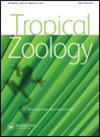Diversity of iron cave-dwelling mygalomorph spiders from Pará, Brazil, with description of three new species (Araneae)
IF 0.7
4区 生物学
Q4 ZOOLOGY
引用次数: 8
Abstract
Mygalomorph spiders are rarely found in caves and most of the records appear as accidental or restricted to small populations. The present study took place in iron formations in Carajás region, southeastern Pará state, eastern Brazilian Amazon rainforest. Each cave was sampled twice: dry season (from May to October) and wet season (from November to April). Of the 242 caves sampled, we found mygalomorphs in 98 (40%). The survey yielded 254 specimens, 223 (87.8%) juveniles. Of the 14 species recorded, nine were represented by adults: Dolichothele tucuruiense (Guadanucci, 2007), Hapalopus aymara Perdomo, Panzera & Pérez-Miles, 2009, Acanthoscurria geniculata (CL Koch, 1841), Theraphosa blondi (Latreille, 1804), Nhandu coloratovillosus (Schmidt, 1998), Fufius minusculus Ortega, Nagahama, Motta & Bertani, 2013, and three new are species described here: Guyruita metallophila n. sp., Hapalopus serrapelada n. sp., and Idiops carajas n. sp. Five other “morphospecies” were represented by juveniles only: Ummidia sp. (Ctenizidae), Paratropis sp. (Paratropididae), Bolostromus sp. (Cyrtaucheniidae), Diplura sp. (Dipluridae), and Idiophtalma sp. (Barychelidae). The high number of juveniles suggests two alternatives: some species could be using the hypogean environment as reproductive shelter; the hypogean environment is used as a refuge by immatures. Two species appear to be troglophiles: G. metallophila and H. aymara. https://zoobank.org/urn:lsid:zoobank.org:pub:C92F29CB-4B9C-402D-8AA6-F8251DE49529.巴西parar穴居铁蛛的多样性及三新种记述(蛛科)
Mygalomorph蜘蛛很少在洞穴中发现,大多数记录都是偶然的或仅限于小种群。本研究发生在巴西亚马逊雨林东部帕拉州东南部卡拉哈斯地区的铁质地层中。每个洞穴取样两次:旱季(5月至10月)和雨季(11月至4月)。在采样的242个洞穴中,我们在98个(40%)中发现了mygalomorphs。此次调查共采集了254个标本,其中223个为幼年标本(87.8%)。在记录的14个物种中,有9个以成虫为代表:Dolichothele tucuruiense(Guadanucci,2007)、Hapalopus aymara Perdomo、Panzera和Pérez-Miles,2009年、Acanthosuria geniculata(CL Koch,1841)、Theraphosa blondi(Latreille,1804)、Nhandu coloratovillosus(Schmidt,1998)、Fufius minusculus Ortega、Nagahama、Motta和Bertani,2013年,和三个新物种:Guyruita metallophila n.sp.、Hapalopus serrapelada n.sp.和Idiops carajas n.sp.。另外五个“形态物种”仅由幼鱼代表:Ummidia sp.(Ctenizidae)、Paratropis sp.(Paratropididae)、Bolostromus sp.(Cyrtaucheniidae),Dipura sp.(Dipuridae)和Idiophtalma sp.(Barychelidae)。幼鱼数量之多表明了两种选择:一些物种可能利用地下环境作为繁殖庇护所;地下环境被未成年人用作避难所。有两个物种似乎是嗜三球菌:G.metallophila和H.aymara。https://zoobank.org/urn:lsid:zoobank.org:pub:C92F29CB-4B9C-402D-8AA6-F8251DE49529。
本文章由计算机程序翻译,如有差异,请以英文原文为准。
求助全文
约1分钟内获得全文
求助全文
来源期刊

Tropical Zoology
生物-动物学
CiteScore
2.50
自引率
0.00%
发文量
1
审稿时长
>12 weeks
期刊介绍:
Tropical Zoology is an international zoological journal publishing original papers in the field of systematics, biogeography, phylogeny, ecology and conservation of all terrestrial and aquatic animal Phyla from tropical and subtropical areas.
Only papers with new information, high quality and broad interest are considered. Single species description and checklists are not normally accepted. Review papers are welcome. The journal is owned by the Istituto di Ricerca sugli Ecosistemi Terrestri of the Consiglio Nazionale delle Ricerche, Florence, Italy (CNR-IRET) who performs research into the structure and functioning of aquatic and terrestrial ecosystems, focusing in particular on anthropogenic pressure and global change. The knowledge amassed forms the scientific basis for identifying the most appropriate protective and corrective interventions, and provides support for the bodies entrusted with formulating policies for environmental protection and recovery.
 求助内容:
求助内容: 应助结果提醒方式:
应助结果提醒方式:


